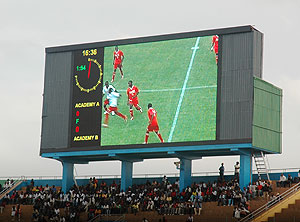THOUGH giant screens were installed on the country’s leading stadiums in 2008 to bring revenues to the government of Rwanda, their impact to the economic growth of the country is yet to be accomplished. The state-of-the-art Large Screens were installed at Amahoro, Nyamirambo and Petit Stadia by Rwanda Information Technology Agency (RITA), a branch of the Rwanda Development Board (RDB) under the request of the Ministry of Sports and Culture.


THOUGH giant screens were installed on the country’s leading stadiums in 2008 to bring revenues to the government of Rwanda, their impact to the economic growth of the country is yet to be accomplished.
The state-of-the-art Large Screens were installed at Amahoro, Nyamirambo and Petit Stadia by Rwanda Information Technology Agency (RITA), a branch of the Rwanda Development Board (RDB) under the request of the Ministry of Sports and Culture.
The total investment of the technologies is still concealed as RITA/RDB have not only adamantly refused to react on some of questions but also failed to meet this reporter.
Skepticism among advertisers
Apart from streaming live video feeds, the screens are used to relay general branding advertisements and promotions for the public and private sector to market different products and services to the general public especially during intervals and breaks.
However, the screens have not been used on a regular basis for ever since they were launched.
Bralirwa’s Marketing Officer Freddy Biniga said that they have never branded their products via the screens because they are yet to realize the operations of the screens. "The screens have to be operational to attract public as well as private companies.
The Screen management has to be fully operational for us to start using them. Our target is aimed at reaching out to a large public so once there are no people in stadiums; branding/advertising with screens won’t be of any use”, Biniga said, adding that the company is still growing thus prioritize in other concerns to meet their profits.
Bralirwa has managed to advertise their products at Petit Stadium’s screen annually from the quarter final stage until the finals of the European UEFA Champions league and they are shifting to the bigger stadium.
Rwanda’s Mobile Telecommunication Network (MTN), used the screen for commercial purposes this year during the Peace Cup football competition and the One Dollar Campaign.
According to MTN’s Events, promotion Coordinator, Alain Numa, the costs of advertising is always included in the sponsorship package thus there is no fixed price set to use the screen alone.
"The reason why we don’t use the screen for commercial purposes regularly is because MTN is always targeting where there is a bigger magnitude of people”, Numa said, adding that they hope to use the screen this time round as the company is set to start publicizing the 2010 World Cup finals which will be held in South Africa.
Management criticized
However, a reliable source from MTN also stressed out that the other reason why the screens were not attractive is due to the poor operational management of the screen. "There is no appropriate management of the screens to attract public or private companies’ investment.
This technology will earn profits if there is a streamlined and effective management structure”, the source said.
Rwandatel, another telecommunication company in the country has also used the giant screens for commercial purposes this year but they also had their concern towards the immediate managers.
They advertised both the Miss Rwanda contest and Umusaruro (a house-winning competition) prior to the start of the 2010 World/Nations cup qualifier match between Rwanda and Zambia at Amahoro stadium on November 14.
But a reliable source from this company also pointed out that for Rwandatel to advertise, a negotiable arrangement was reached between the company and the Sports Ministry.
"It was like an exchange of services”, this official said, adding that for Rwandatel to improve on the advertising modes, the Sports Ministry should reduce on the cost of services. "The Ministry of Sports and Culture should make the rates affordable. The prices are high and this limits our advertising frequencies”, this source said.
No fixed rate
However, efforts of finding the actual cost of the advertising rates on that specific day were futile as always. Nobody from Rwandatel and Sports Ministry was willing to point out the costs.
The Permanent Secretary in the Ministry of Sports and Culture Jean Pierre Karabaranga said that they are no defined or fixed advertising rates for anyone to brand his/her products via the screens.
According to Karabaranga, once they get advertisers, 80% of the collected funds go to the Finance Ministry while the 20% is left for the advertiser.
Giving an example of a premier football match being held at Amahoro stadium, the host club rents the stadium and the screen usage is included in the whole package. Then 80% of the revenues collected on that day go to the Ministry of Sports while 20% goes to the host club.
However, the reason why the screens are yet to be attractive is due to the lack of interest from companies to advertise their products. "At the moment, rates (unknown) are not expensive as many companies seem to say.
We reach negotiable deals with companies interested in bringing in their commercials but the turn up is still low.
We called for bids from interested people this year to contract the renting of the screens as well as take up the management and market tasks so as to improve on their revenues but surprisingly none came”, Karabaranga said.
The administrator further added that advertising on the screens cannot be put on a promotion basis because the government wants to gain revenues from the technology.
"How can we put this technology on a promotion basis when we have to pay for the screens’ revenues?” Karabaranga questioned.
Ends


